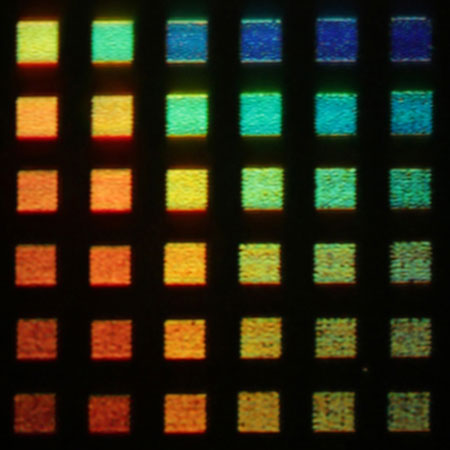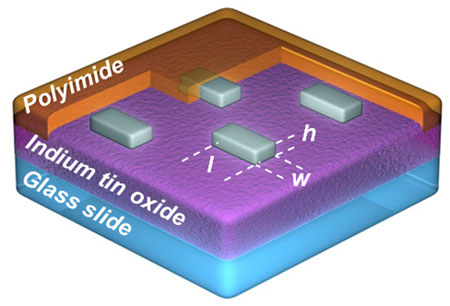| Posted: Sep 16, 2014 |
Artificial 'squid skin' nanophotonics project yields vivid color display
|
|
(Nanowerk News) The quest to create artificial “squid skin” — camouflaging metamaterials that can “see” colors and automatically blend into the background — is one step closer to reality, thanks to a breakthrough color-display technology unveiled this week by Rice University’s Laboratory for Nanophotonics (LANP).
|
 |
| Rice University's new color display technology is capable of producing dozens of colors, including rich red, green and blue tones comparable to those found in high-definition LCD displays. (Image: J. Olson/Rice University)
|
|
The new full-color display technology uses aluminum nanoparticles to create the vivid red, blue and green hues found in today’s top-of-the-line LCD televisions and monitors. The technology is described in a new study that will be posted online this week in the Early Edition of the Proceedings of the National Academy of Sciences ("Vivid, full-color aluminum plasmonic pixels").
|
|
The breakthrough is the latest in a string of recent discoveries by a Rice-led team that set out in 2010 to create metamaterials capable of mimicking the camouflage abilities of cephalopods — the family of marine creatures that includes squid, octopus and cuttlefish.
|
|
“Our goal is to learn from these amazing animals so that we could create new materials with the same kind of distributed light-sensing and processing abilities that they appear to have in their skins,” said LANP Director Naomi Halas, a co-author of the PNAS study. She is the principal investigator on a $6 million Office of Naval Research grant for a multi-institutional team that includes marine biologists Roger Hanlon of the Marine Biological Laboratory in Woods Hole, Mass., and Thomas Cronin of the University of Maryland, Baltimore County.
|
|
“We know cephalopods have some of the same proteins in their skin that we have in our retinas, so part of our challenge, as engineers, is to build a material that can ‘see’ light the way their skin sees it, and another challenge is designing systems that can react and display vivid camouflage patterns,” Halas said.
|
|
LANP’s new color display technology delivers bright red, blue and green hues from five-micron-square pixels that each contains several hundred aluminum nanorods. By varying the length of the nanorods and the spacing between them, LANP researchers Stephan Link and Jana Olson showed they could create pixels that produced dozens of colors, including rich tones of red, green and blue that are comparable to those found in high-definition LCD displays.
|
|
“Aluminum is useful because it’s compatible with microelectronic production methods, but until now the tones produced by plasmonic aluminum nanorods have been muted and washed out,” said Link, associate professor of chemistry at Rice and the lead researcher on the PNAS study. “The key advancement here was to place the nanorods in an ordered array.”
|
 |
| Rice researchers tune the color output of each array both by varying the length of the nanorods and by adjusting the length of the spaces between nanorods. (Image: J. Olson/Rice University)
|
|
Olson said the array setup allowed her to tune the pixel’s color in two ways, first by varying the length of the nanorods and second by adjusting the length of the spaces between nanorods.
|
|
“This arrangement allowed us to narrow the output spectrum to one individual color instead of the typical muted shades that are usually produced by aluminum nanoparticles,” she said.
|
|
Olson’s five-micron-square pixels are about 40 times smaller than the pixels used in commercial LCD displays. To make the pixels, she used aluminum nanorods that each measured about 100 nanometers long by 40 nanometers wide. She used electron-beam deposition to create arrays — regular arrangements of nanorods — in each pixel.
|
|
She was able to fine-tune the color produced by each pixel by using theoretical calculations by Rice physicists Alejandro Manjavacas, a postdoctoral researcher, and Peter Nordlander, professor of physics and astronomy.
|
|
“Alejandro created a detailed model of the far-field plasmonic interactions between the nanorods,” Olson said. “That proved very important because we could use that to dial in the colors very precisely.”
|
|
Halas and Link said the research team hopes to create an LCD display that uses many of the same components found in today’s displays, including liquid crystals, polarizers and individually addressable pixels. The photonic aluminum arrays would be used in place of the colored dyes that are found in most commercial displays. Unlike dyes, the arrays won’t fade or bleach after prolonged exposure to light, and the inherent directionality of the nanorods provides another advantage.
|
|
“Because the nanorods in each array are aligned in the same direction, our pixels produce polarized light,” he said. “This means we can do away with one polarizer in our setup, and it also gives us an extra knob that we can use to tune the output from these arrays. It could be useful in a number of ways.”
|
|
Link and Halas said they hope to further develop the display technology and eventually to combine it with other new technologies that the squid skin team has developed both for sensing light and for displaying patterns on large polymer sheets. For example, Halas and colleagues published a study in Advanced Materials in August about an aluminum-based CMOS-compatible photodetector technology for color sensing. In addition, University of Illinois at Urbana-Champaign co-principal investigator John Rogers and colleagues published a proof-of-concept study in PNAS in August about new methods for creating flexible black-and-white polymer displays that can change color to match their surroundings.
|
|
“We hope to eventually bring all of these technologies together to create a new material that can sense light in full color and react with full-color camouflage displays,” Halas said.
|


